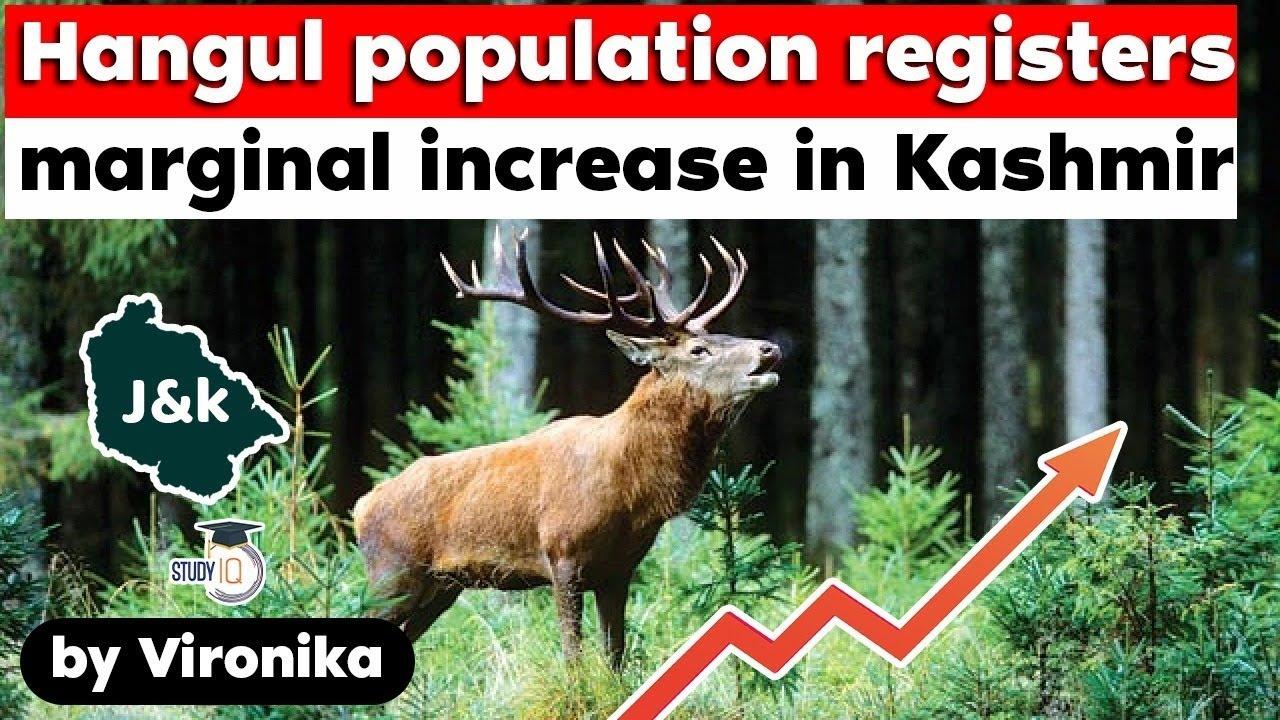Table of Contents

- In March 2021, a census conducted in Kashmir to estimate the population of the hangul (Kashmir stag), showed encouraging initial findings.
- According to the Department of Wildlife Protection, the population of the critically endangered species has registered a marginal increase in the Kashmir Valley.
- Pertinently, in the last three consecutive surveys conducted after every two years, the population of Hangul had shown small upward trend.
- In 2015, the Hangul population was 186, in 2017 and 2019 it was 197 and 237 respectively and it is now 261.
Historical Background
- The state animal of the erstwhile Jammu and Kashmir, the hangul was first identified by researcher Alferd Wagner in 1844.
- The species is believed to have travelled all the way from Bukhara in Central Asia to Kashmir.

- The name hangul comes from the preferred food of the deer, which is the Indian horse chestnut (also known as ‘Han Doon’ locally). It also eats a wide variety of grass, herbs, shrubs and foliage.
- In the 1900s, the hangul was found in abundance in northern Kashmir, Himachal Pradesh and Pakistan. Now its range is restricted to the Dachigam National Park near Srinagar.
- Hangul shed their horns around March and move to higher altitudes. Their horns regrow around August and they return to lower altitudes by September-October.
- This is usually the best time to spot them in the Kashmir region. It also marks the rutting season, when the males court females by showing off their antlers and fighting with competitors.
- Hangul generally prefer to live in groups of 2-18, but adult males become intolerant of each other during the rutting season.
- After about eight months, a single fawn (in rare cases, twins) is born to the female. The female hangul will take care of the fawn till it reaches maturity at 16 months
The fall of the hangul population
- In the 1900s, around 3,000 to 5,000 hangul could be found in Kashmir, from Karen in the Kishenganga catchments to Dorusa in Lolab Valley, and the catchments in Bandipora, Tulail, Baltal, Aru, Tral and Kishtwar.
- Incessant hunting resulted in a decline in their numbers. This led the then Maharaja of Kashmir to create game reserves such as Dachigam where locals were restricted from hunting.
- After independence, the creation of sanctuaries and national parks further reduced the threat of hunting.
- A more recent cause for their declining numbers is the skewed fawn to female and male to female ratios. The 2019 census data showed that there were 7.5 fawns per 100 females and 15.5 males per 100 females.
Significance of Hangul
- As a herbivore, the hangul plays an important role as a prey to predators like the leopard and the Himalayan bear.
- It also ensures that the grassland lines survive in the upper forest ranges which are not easy to reach for most animals.
Need of the census
- Constant and regular population monitoring is the only way researchers, scientists and conservationists can get a general idea about a species that is otherwise hard to locate or observe all-year long.
- At the moment, the most critical aspect to hangul conservation would be to restore the imbalance of the male to female and fawn to female ratios. This is why conducting a census every two years becomes essential.
Biggest Threat
- The biggest challenges which have been identified by experts in the way of conservation and population growth of Hangul are habitat fragmentation, predation and very low fawn-female ratio.
Present Working
- A project kicked off by Sher-e-Kashmir University of Agricultural Sciences and Technology, along with scientists from the Smithsonian Institution of the U.S., is working towards conservation breeding, conservation genetics and community development.
- Their plan is to create a founder breeding stalk by capturing Hangul from the wild and then run a breeding programme.
- The hangul continues to remain the state animal of Kashmir and there is some evidence that the animal returning to its earlier habitats.
- Last year, a wild herd of around 6 to 8 deer was reported to have been sighted in central Kashmir’s Ganderbal district.
Question:
Which of the national park is not located in Jammu & Kashmir?
- Hemis National Park
- Kishtwar National Park
- Dachigam National Park
- Great Himalayan National Park
Latest Burning Issues | Free PDF






















 WhatsApp
WhatsApp